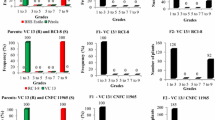Abstract
Seven primitive races ofGossypium hirsutum L.punctatum, marie-galante, richmondi, latifolium, morrilli, palmeri, mexicanum and five F1 crosses were inoculated withFusarium f. sp.vasinfectum physiological strain I. in the wilt field of Cixi Cotton Institute in 1987. There were highly significant differences among these primitive races.Punctatum andpalmeri were highly resistant. The resistances ofmarie-galante andmexicanum was similar with that of cultivar ‘Simian2’;richmondi, latifolium andmorrilli were susceptible. The disease incidence of F1 in five primitive races hybridized with cultivar ‘Simian2’ was generally higher than that of mid-parent value. Inheritance of wilt resistance was partially dominant. In addition, 178 accessions of eight primitive races were evaluated for their resistance as before in 1989. There were significant differences in resistance among races and intra-race accessions. There were wilt resistance accessions among primitive races in which disease incidence was below 10%–25%. Inpalmeri, marie-galante, richmondi andpunctatum, one accession was immune with 0% disease incidence, respectively; 22.7–77.4% accessions were susceptible with 50% disease incidence. It showed that primitive races were mixed populations. They should be evaluated and screened for their utilization in cotton breeding program. Some best plants were selected from F2 of two crosses, ‘Simian2’ ×palmeri and ‘Simian2’ ×mexicanum, based on the resistance toFusarium wilt and the response to photoperiod. 11 lines had been obtained with good fiber quality and relatively high potential production by backcrossing improvement. These lines are now being tested.
Similar content being viewed by others
References
Benedict, C.R., 1984. Physiology. In: R.J. Kohen & C.F. Lewis (Ed.), Cotton Agron. Monogr. 24, pp. 151–200, ASA, Madison.
Bridge, R.R. & L.D. McDonald, 1987. Beltwide efforts and trends in development of varieties for short-season production systems. In: J.M. Brown (Ed.), Beltwide Cotton Prod. Res. Conf., Dallas, TX, 4–8 Jan. 1987, pp. 81–85, Nat'l Cotton Council of America, Memphis.
Hu Shaoan, 1987. Study on growth ofGossypium hirsutum races. China Cottons (1): 7–10.
Hutchinson, J.B., 1951. Intra-specific differentiation inGossypium hirsutum. Heredity 5: 161–193.
Kappelman, A.J. et al., 1979. Wilt resistance in day-neutral selections from primitive races of cotton and crosses of race selections with a commercial cultivar. Crop Sci. 19: 795–798.
Kappelman, A.J.,1980. Long-term progress made by cotton breeders in developingFusarium wilt resistant germplasm. Crop Sci. 20: 613–615.
Kohel, R.J. & T.R. Richmond, 1962. The genetics of flowering response in cotton. IV. Quantitative analysis of Texas 86,Gossypium hirsutum racelatifolium in a cross with an inbred of cultivated American Upland cotton. Genetics 47: 1535–1542.
Kohel, R.J. et al., 1974. The genetics of flowering response in cotton. VI. Flowering behavior ofGossypium hirsutum andG. barbadense hybrids. Crop Sci. 14: 696–699.
Kohel, R.J. et al., 1977. Symposium physiological research in cotton germplasm. Proc. Beltwide Cotton Prod. Res. Conf. P53.
Meredith, W.R., 1991. Cotton. In: H.L. Shands & L.E. Wiesner (Ed.), Use of Plant Introductions in cultivar development. Part 1. CSSA Spec. Pub. No. 17, pp. 127–146, CSSA, Madison.
Shen Duanzhuang et al., 1985. A preliminary study of introduction ofG. hirsutum races. Crop Genetic Resources (1): 28–32.
Wilhelm, S., J.E. Sagen & H. Tietz, 1974.Gossypium hirsutum subsp.mexicanum var.nervosum, Leningrad Strain — A source of resistance toVerticillum wilt. Phytopathology 64: 931–939.
Zheng Sijun, Ji Daofan & Xu Fuhua, 1989a. Study on characteristics ofGossypium hirsutum L. races. Zhejiang Agricultural Science (1): 27–30.
Zheng Sijun, Ji Daofan & Xu Fuhua, 1989b. Wilt resistance in some wild races ofGossypium hirsutum L. with reference to its inheritances. Crop Genetic Resources (2): 20–22.
Zheng Sijun, Ji Daofan & Xu Fuhua, 1989c. Photoperiodic effect and inheritance of flowering response ofGossypium hirsutum L. races. Acta Agriculturae Zhejiangensis 1: 8–13. (In Chinese).
Zheng Sijun, Ji Daofan, Xu Fuhua, 1991. Cross compatibility analysis ofGossypium hirsutum racelatifolium with commercial varieties. Acta Botanica Boreali-occidentalia Sinica 11(2): 125–128. (In Chinese).
Author information
Authors and Affiliations
Rights and permissions
About this article
Cite this article
Zheng, S., Ji, D. & Xu, F. Evaluation ofFusarium wilt-resistance in primitive races ofGossypium hirsutum L.. Genet Resour Crop Evol 42, 257–261 (1995). https://doi.org/10.1007/BF02431260
Received:
Accepted:
Issue Date:
DOI: https://doi.org/10.1007/BF02431260




